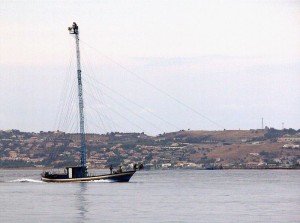
The method of hunting the swordfish using passerelle, the strange boats that seem to hover over the water, is really no more than an updated version of an ancient method, used by the Phoenicians who traded the length and breadth of the Mediterranean, hundreds of years before the time of Christ.
Whereas most other fish are not seen until they are caught, either by hook or by net, the swordfish hunt doesn’t begin until the fish is sighted. It is much closer to an animal hunt on land than it is to what one normally thinks of as fishing.
The hunt begins with the ‘spotter’, whose job it is to identify the presence of the swordfish, either from a direct sighting or a change in the surface of the water. Originally, the spotter would have been situated on rocks or hills above the coast, relaying sighting information, either by shouting set, traditional phrases, or waving flags, to crews waiting in the boats below.
Once harpooned, the fish would be given a lot of line and, with it, a temporary illusion of freedom. Finally, weakened from the struggle and loss of blood, it would be hauled into the boat. There, again following an ancient tradition, one of the fishermen would make four crosses with his fingernail just above the eye of the fish, and cut out the block of flesh surrounding the harpoon wound and this would be given to the harpoonist.
In recent years, this wooden boat has morphed into a big hunting machine, the passarella, powered by a diesel motor. While in principle the method hasn’t changed, it is obviously now much more sophisticated. At the centre of the boat there is a large metal frame or tower, usually about 30 metres high, with an iron cage at the top. The spotter in these boats has two roles: he both sights the fish and pilots the boat, making the chase much more accurate and effective. Extending 45 metres out from the front of the boat is another long, light iron bridge, known as the passarella; here, the harpooner takes his position. Because he is able to position himself directly above the fish, it is much easier than it used to be for him to aim the harpoon accurately – also, because the passarella extends so far from the boat, the fish does not hear the motor and is caught unawares.
It seems the swordfish doesn’t stand much chance any more.